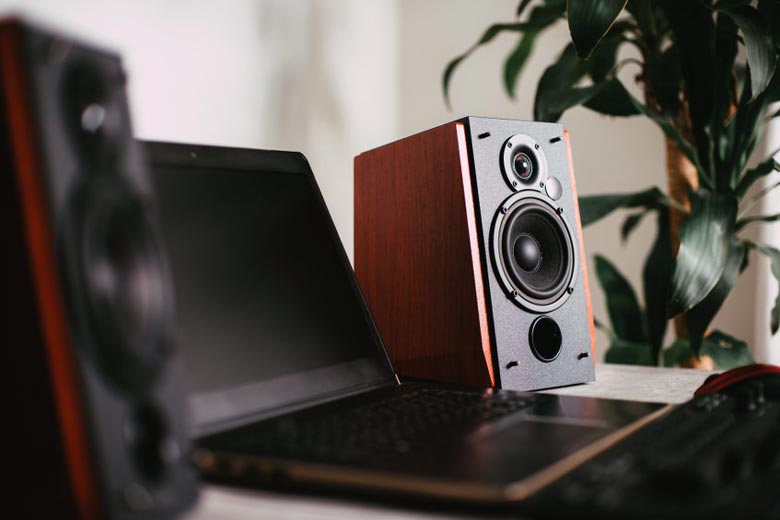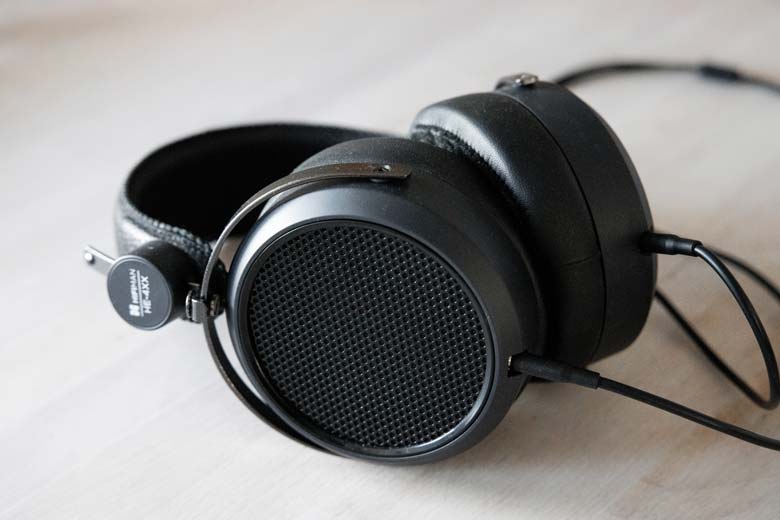Getting an audiophile-grade music experience requires hi-fi equipment different from regular music-hearing devices. You may think that a computer can’t deliver audiophile quality sound because it’s not a dedicated audio device. But it’s possible to turn your computer into a source of hi-fi sound.
Get a set of high-quality active speakers, connect them to your computer via cable, add a subwoofer if needed, and position your speakers correctly. You can use high-quality headphones instead of speakers if you’d like. Add an external DAC to get cleaner sound and choose high-resolution audio files or a HiFi streaming service.
This article explores these solutions in greater detail. Read on to see how you can turn your computer into an audiophile-grade audio device.

1. Get High-Quality Speakers
The most important thing that can give you high fidelity and accurate sound is the speaker. If you have cheap computer speakers or even use your computer’s internal speakers, the sound isn’t heard the way it was intended. And it certainly isn’t hi-fi.
With that said, some new computers actually have quite decent internal speakers but your laptop or desktop’s built-in speakers won’t give you the high-fidelity sound you want.
However, with a high-end speaker, you can take your music experience to the next level.
Passive or active speakers?
There are two types of speakers to choose between; active or passive speakers.
The difference between active and passive speakers is that active speakers have a built-in amplifier while passive speakers don’t. The amplifier in active speakers makes it possible to connect them directly to your audio source (your computer e.g.). Passive speakers, on the other hand, need a separate amplifier to drive them.
In the latter case, you need to connect the amplifier to your computer and then connect the speakers to the amplifier.
Both types of speakers can thus be used for a computer but it makes the most sense to choose a pair of active speakers if you actually plan to use them as computer speakers.
You save both space and money by not needing to invest in a separate amplifier. However, if you already have an amp and a nice pair of passive speakers it can be a great alternative to use them with your computer to maximize your listening experience.
Computer speakers to consider
There are a huge amount of computer speakers to choose from! Unfortunately, that can be quite intimidating when trying to find out which ones to buy.
I think that Audio Advice has done a great job choosing some of the best computer speakers right now in this video:
I would also like to add the popular and very beautiful KEF LSX to the list, the smaller sibling to the mighty KEF LS50 Wireless II (which instead might be a great option for a living room). The smaller form factor makes it ideal for the desktop and the sound would surprise you.
Here are the speakers talked about in the video:
2. Add a Subwoofer to the Speakers
If you’re not low on budget and space, adding a subwoofer can be a really nice addition to your listening experience. Getting a subwoofer helps get deep bass, something many audiophiles ignore.
There are different types of subwoofers, each serving a different purpose. Sealed-box subs provide a tight and punchy bass, while ported subs deliver deep bass. The bigger the sub, usually the deeper the bass.
However, getting the crossover frequency right is critical when using a sub, as it’s the frequency at which it and the speaker start to produce bass notes.
If your speaker has a frequency, set the sub’s frequency 10 HZ above that value to get the crossover frequency. Then, listen to the sound and check the bass. If some notes show a dip in the bass, raise the frequency; if they sound bloated, lower it. Continue until all notes have even bass.
In addition, you should place the sub in the optimal place to get the best bass.
The only way to get this placement right is by trial and error.
Place it in different parts of the room, listen to the audio, and see when you can get the best bass.
If you don’t know which subwoofer goes with your speaker, you can try this online tool. It recommends subs based on the brand and model of your speaker.
Read more: Can a Subwoofer Be Placed on a Shelf?
3. Use High-Quality Headphones (Alternative to Speakers)
Headphones can be a great alternative to speakers! Some people actually prefer headphones over speakers, for multiple reasons.
Headphones aren’t just more convenient and can easily be used wherever you are, they also make it easier to not disturb others (and the other way around). Also, they don’t take up much space, you can easily put them away, and you generally get more bang for your buck with headphones.

The sound from headphones is not affected by your surroundings the way the sound from speakers is.
The listening distance, the direction of the sound, and the positioning of the speakers are things you don’t need to worry about when listening to headphones.
However, there are of course some drawbacks with headphones compared to speakers as well.
Headphones are not for everybody, especially if you are not planning to use them anywhere else besides by the computer. The soundstage, the feeling of the bass, and the comfort while listening are all better with speakers.
For a more in-depth comparison between speakers and headphones, read our article on speakers vs headphones.
It all depends on the situation and your preferences, but headphones are definitely a great option for getting audiophile quality sound from your computer.
Types of headphones
There are multiple types of headphones to choose from but the most common ones for this purpose are over-ear headphones and in-ear headphones.
Over-ear headphones
Over-ear headphones are made in two types; closed back or open back, and it’s important to understand the difference before buying a pair.
The main difference between open-back headphones and closed-back headphones is that closed-back headphones will isolate some of the sounds around you while models with open backs won’t.
However, some open-back headphones will offer a better sound stage and a more airy experience. Some open-back models can also be more comfortable to wear for longer periods of time, especially if you know that you easily get warm.
With that said, there are a lot of really good closed-back models that definitely sound fantastic as well!
If you are listening alone without noise around you, open-back headphones can be an option.
However, if you plan to use your headphones on the go or in a more crowded place as well, then you should consider closed-back headphones instead.
Some closed-back headphones also offer an active noise cancellation feature which is great if you also will use your headphones on the train, subway, airplane, or whatever noisy environment.
Here are some of the best over-ear headphones right now:
In-ear headphones
Over-ear headphones might be more common for audiophiles but in-ear headphones can definietly be a great choice for superb audio quality from your computer.
They are even more convenient, less eye-catching, and easier to travel with than their bigger alternative.
Some might think that you have to get really big headphones to get great sound quality. That’s not true.
These small earphones can actually produce extremely high fidelity audio and some audiophiles prefer in-ear instead of over-ear headphones.
Also, read our article where we compare IEMs (In-Ear Monitors) vs. over-ear headphones.
Here are some of the best in-ear headphones (IEMs) right now:
4. Get an External DAC
Once you’ve added the perfect speaker and subwoofer to your audiophile setup, it’s time to ensure the computer can send sound signals to the speakers effectively.
The sound played and produced by the computer is in digital form. However, the speakers work with analog data. So, you need a Digital-to-Analog Converter to turn digital signals into analog ones.
Computers, as well as powered speakers, have built-in DACs, but an external DAC works much better at converting signals and producing a more accurate sound.
Don’t worry about the two internal and external DACs messing with the sound because the external DAC bypasses the internal one when connected properly.
If you use headphones, you could go for a DAC and amp combo that boost the sound with their built-in amplifier and digital to analog converter. You could also get a separate DAC and amp if you want, but you may not notice a big difference if you get a high-quality combo.
Read more: Do You Need BOTH a DAC and an AMP?
If you want a portable DAC that works just as great with your laptop/desktop as with your phone, I would totally recommend the AudioQuest DragonFly Cobalt! It’s small, lightweight, and affordable, still, it’s powerful enough to drive almost all headphones on the market.
You could also check out another DragonFly model, like the black version (link to Amazon), which is even more affordable.
If you don’t need portability and rather want a desktop DAC, I would recommend the fantastic DacMagic 200M from Cambridge Audio or the iFi Zen Dac V2.
So here are some of the best DAC/amp combos right now:
5. Use a Hi-Fi Streaming Service
Streaming services offer the most convenient solution to playback music these days. You only need a subscription and a good internet connection to have millions and millions of songs available with your computer. That’s insane!
The thing is, streaming isn’t always the best option if you need audiophile quality sound. Many streaming services simply don’t deliver audio in high fidelity. That’s why you have to be careful when choosing which service to go for.
Fortunately, there are some great services that do offer music of really high audio quality.
I would definitely recommend Tidal, which is a very respected and highly rated streaming service for audiophiles. It’s not the cheapest option but I love it, it’s fantastic!
And Tidal does offer a free trial, so there is no reason not to try it out!
6. Listen to High-Resolution Files
The type of audio file you listen to greatly affects the final sound quality you hear. Instead of streaming in low quality, download your music with high resolutions to ensure the source audio doesn’t skimp on quality.
Also, choose lossless formats over lossy ones because they don’t sacrifice quality for storage and speed. For instance, instead of using the mp3 format, go for FLAC and ALAC files.
These lossless files deliver the ultimate high-fidelity sounds that the musician intended for you to hear. They capture 100% percent of the data and deliver it to you.

The catch is their larger size, which may require you to store these files on an external hard drive. However, it may also ultimately help you in your audiophile experience because you’ll separate your audio storage from your computer, allowing it to work at its full capacity.
Related article: How To Listen Like an Audiophile (Complete Guide)
Conclusion
Getting audiophile-grade audio from your computer isn’t difficult and doesn’t have to be extremely costly. The most important thing is your speaker, so you can shop around and look for a hi-fi speaker within your budget. Or choose a pair of headphones for even more bang for your buck.
An external DAC and a headphone amp can also deliver a more accurate sound by handling audio signals more effectively and driving the headphones sufficiently.
If you go for speakers, a subwoofer could be a great way of giving your listening experience an extra oomph.
Finally, try to get high-quality audio from the source by downloading high-resolution files in lossless formats or by using a Hi-Fi streaming service.
None of this equipment will make a huge difference unless you’re also listening to high-quality sound files. Additionally, the more external devices you’re using, the more possibilities you have for a break in the high-quality chain. If you have a stellar DAC and master-quality audio files, but you’re using the earbuds that came free with your cell phone, the audio quality will not be as good as if you were using a high-end pair of headphones.




















